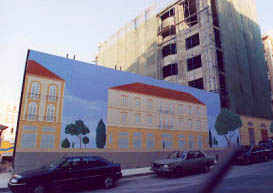
The combined effort of Solidere and the artists at first glance makes one doubt that there ever really was a war. Which is precisely the effect Solidere was after. The murals fit the mood of the already completed construction in the middle of the new downtown, where extra-wide cobblestone streets are flanked with rows of buildings in soothing tans and yellows. It's a wealth of space and air that is an extreme relief after the crushing crowded modernity of Hamra, the current center of Beiruti activity. All this grandeur doesn't come cheap--at least 700 million US dollars for the infrastructure alone, according to Solidere spokesperson Nabil Rached. "If Solidere didn't exist, the reconstruction wouldn't exist either," said Succar. Succar herself is a new spirit in Beirut, the Arab capital where one sees carefully coifed women in form-revealing designer clothes.
Next Page
Previous Page
Caught in the cross fire: Is Beirut Ready for Tourism?
Marriage: Lebanese Style
Meet Lebanon's only Male Belly Dancer
Christians Looking for a Better Future
A Visit to a Palestinian Camp
CONTACT US
WHO ARE WE?
Back to Home Page